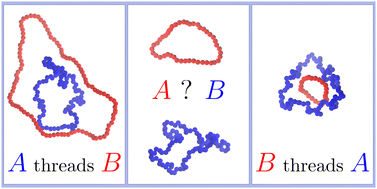To thread or not to thread? Effective potentials and threading interactions between asymmetric ring polymers†
Abstract
We use computer simulations to study a system of two unlinked ring polymers, whose length and bending stiffness are systematically varied. We derive the effective potentials between the rings, calculate the areas of minimal surfaces of the same, and characterize the threading between them. When the two rings are of the same kind, threading of a one ring through the surface of the other is immanent for small ring–ring separations. Flexible rings pierce the surface of the other ring several times but only shallowly, as compared to the stiff rings which pierce less frequently but deeply. Typically, the ring that is being threaded swells and flattens up into an oblate-like conformation, while the ring that is threading the other takes a shape of an elongated prolate. The roles of the threader and the threaded ring are being dynamically exchanged. If, on the other hand, the rings are of different kinds, the symmetry is broken and the rings tend to take up roles of the threader and the threaded ring with unequal probabilities. We propose a method how to predict these probabilities based on the parameters of the individual rings. Ultimately, our work captures the interactions between ring polymers in a coarse-grained fashion, opening the way to large-scale modelling of materials such as kinetoplasts, catenanes or topological brushes.

- This article is part of the themed collection: Soft Matter Emerging Investigators Series


 Please wait while we load your content...
Please wait while we load your content...